Stephen Morris's Blog, page 53
August 15, 2013
Elizabeth Bathory
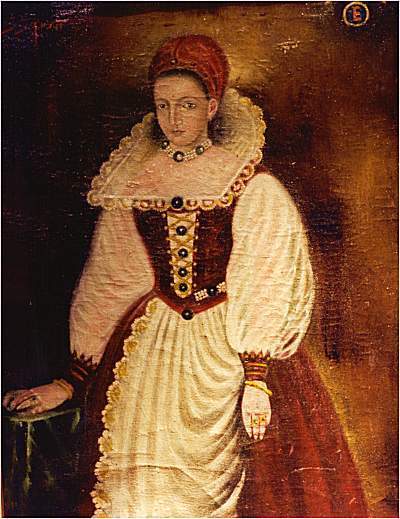
Copy of the lost 1585 original portrait of Erzsébet Báthory
(disappeared in the 1990s)
Countess Elizabeth Báthory de Ecsed (Báthory Erzsébet in Hungarian, Alžbeta Bátoriová in Slovak; 7 August 1560 – 14 or 21 August 1614) was a countess from the renowned Báthory family of nobility in the Kingdom of Hungar. She has been labelled the most prolific female serial killer in history and is remembered as the “Blood Countess,” though the precise number of victims is debated.
After her husband Ferenc Nádasdy’s death, she and four collaborators were accused of torturing and killing hundreds of girls, with one witness attributing to them over 650 victims, though the number for which they were convicted was 80. Due to her rank, Elizabeth herself was neither tried nor convicted. But upon her arrest in December 1610, she was imprisoned in Čachtice Castle, now in Slovakia, where she remained immured in a set of rooms until her death four years later.
Later writings[ about the case have led to legendary accounts of the Countess bathing in the blood of virginsto retain her youth and subsequently also to comparisons with Vlad III the Impaler of Wallachia, on whom the fictional Count Dracula is partly based, and to modern nicknames of the Blood Countess and Countess Dracula.
Báthory was never brought to trial, but her family had her imprisoned in Čachtice Castle for life. She was kept bricked in a set of rooms, with only small slits left open for ventilation and the passing of meals. She remained there for four years, until her death. On 24 August 1614, Elizabeth Báthory was found dead in her room by a guard looking in through one of the slots. Since there were several plates of food untouched, her actual date of death is unknown. She was buried in the church of Csejte, but due to the villagers’ uproar over having “The Tigress of Csejte” buried in their cemetery, her body was moved to her birth home at Ecsed, where it is interred at the Báthory family crypt.
The case of Elizabeth Báthory inspired numerous stories during the 18th and 19th centuries. The most common motif of these works was that of the countess bathing in her victims’ blood to retain beauty or youth. This legend appeared in print for the first time in 1729, in the Jesuit scholar László Turóczi’s Tragica Historia, the first written account of the Báthory case. At the beginning of the 19th century, this certainty was questioned, and sadistic pleasure was considered a far more plausible motive for Elizabeth Báthory’s crimes. In 1817, the witness accounts (which had surfaced in 1765) were published for the first time, which included no references to bloodbaths.
The legend nonetheless persisted in the popular imagination. This myth is speculated to persist in part because of Báthory’s connection to Transylvania and vampire lore. Some versions of the story were told with the purpose of denouncing female vanity, while other versions aimed to entertain or thrill their audience. The vampirism connection extends to the 21st century documentary Deadly Women, where she is profiled in the first episode of the series as maintaining her good looks by iron supplementation she obtained by drinking her victims’ blood.
August 12, 2013
Gladiolus
The long, lovely gladiolus is the birthday flower for August. A member of the iris family, “glads” are also called sword lilies because of their sharply pointed leaves and tall stalks of flowers with pointed tips. The Latin name for Gladiolus is gladius, a clear reference to the sword-swinging gladiators of ancient Rome.
There are 255 species of gladiolus and the plants range in size from two to five feet tall with elegant trumpet-shaped blossoms that grow in a double row along the stem. You can find hybrid varieties with ruffled, wavy or frilled petals and the flowers can be found in every color.
Gladiolus is native to tropical Africa and areas around the Mediterranean and Middle East. It is believed that gladiolus plants were first brought to Europe in the early 18th century. Around the 1820s, gardeners began to seriously cultivate gladiolus and create hybrid varieties that became very popular in gardens and as cut flowers.
In floral history, gladiolus flowers have several different meanings. Because of their association with gladiators, they traditionally symbolize strength, sincerity and moral integrity. Gladiolus flowers also represent remembrance. And even though their sword-shaped leaves hark back to ancient swords and battles, Victorian romantics determined that gladiolus flowers were capable of piercing someone’s heart with their beauty, adding infatuation to the list of traditional floral meanings.
August 8, 2013
Lammas Day, the beginning of autumn

Lammas bread loaves, fresh from the oven on my kitchen counter.
August 1 is Lammas Day (Anglo-Saxon hlaf-mas, “loaf-mass”), the festival of the wheat harvest, and was considered the first day of autumn in the traditional calendar of the pre-modern West (much as Labor Day is the beginning of autumn in the culture of the modern United States). On this day it was customary to bring to church a loaf made from the new crop, which began to be harvested at Lammastide. The loaf was blessed, and in Anglo-Saxon England it might be employed afterwards to work magic; a book of Anglo-Saxon charms directed that the Lammas Bread be broken into four bits, which were to be placed at the four corners of the barn, to protect the garnered grain. In many parts of England, tenants were bound to present freshly harvested wheat to their landlords on or before the first day of August. In the Anglo-Saxon Chronicle, where it is referred to regularly, it is called “the feast of first fruits”. (In Eastern Europe, the first honey of the season was brought to church to be blessed on August 1.)
As the wheat must have run low in the days before Lammas, and the new harvest began a season of plenty, of hard work and company in the fields, reaping in teams, [7] there was a spirit of celebratory play. In the medieval agricultural year, Lammas also marked the end of the hay harvest that had begun after Midsummer. At the end of hay-making a sheep would be loosed in the meadow among the mowers, for him to keep who could catch it.
In Shakespeare’s Romeo and Juliet (1.3.19) it is observed of Juliet, “Come Lammas Eve at night shall she [Juliet] be fourteen.” Since Juliet was born Lammas eve, she came before the harvest festival, which is significant since her life ended before she could reap what she had sown and enjoy the bounty of the harvest, in this case full consummation and enjoyment of her love with Romeo.
August 5, 2013
Witches and Wicked Bodies
I would love to get to see this exhibit! There are also some interesting talks scheduled that I want to hear, and the catalogue I want to buy! Let’s make a group tour of Scotland and all go to the exhibit together, okay?
The gallery website describes the exhibit:
“Discover how witches and witchcraft have been depicted by artists over the past 500 years, including works by Albrecht Dürer, Francisco de Goya and William Blake, plus pieces by 20th century artists such as Paula Rego and Kiki Smith.
Through 16th and 17th century prints and drawings, learn how the advent of the printing press allowed artists and writers to share ideas, myths and fears about witches from country to country.
Including major works on loan from the British Museum, the National Gallery (London), Tate, the Victoria & Albert Museum, as well as works from the Galleries’ own collections, Witches and Wicked Bodies will be an investigation of extremes, exploring the highly exaggerated ways in which witches have been represented, from hideous hags to beautiful seductresses.”
August 1, 2013
Edward Kelley
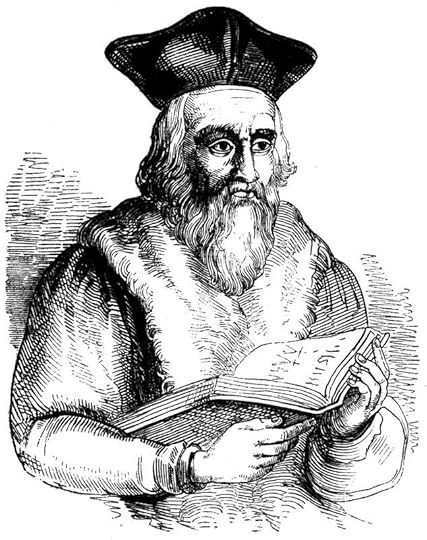
Edward Kelley, English alchemist, died inPrague after attempting to escape by jumping out a window and breaking his leg (and other bones).
Sir Edward Kelley, also known as Edward Talbot (August 1, 1555 – November 1, 1597), was an ambiguous figure in English Renaissance occultism and self-declared spirit medium who worked with John Dee in his magical investigations. (See the previous post on John Dee here.) Besides the professed ability to summon spirits or angels on a crystal ball, which John Dee so valued, Kelley also claimed to possess the secret of transmuting base metals into gold.
Legends began to surround Kelley shortly after his death. His flamboyant biography, and his relative notoriety among English-speaking historians (chiefly because of his association with Dee) may have made him the source for the folklorical image of the alchemist-charlatan.
Kelley approached John Dee in 1582. Dee had already been trying to contact angels with the help of a scryer, or crystal-gazer, but he had not been successful. Kelley professed the ability to do so, and impressed Dee with his first trial. Kelley became Dee’s regular scryer. Dee and Kelley devoted huge amounts of time and energy to these “spiritual conferences”. From 1582 to 1589, Kelley’s life was closely tied to Dee’s. In those seven years, they conducted these conferences, including “prayers for enlightenment… in the spirit of Dee’s ecumenical hopes that alchemy and angelic knowledge would heal the rift of Christendom”.
Kelley married a widow, Jane Cooper of Chipping Norton (1563–1606). He later helped educate her children and she described him as a ‘kind stepfather’ and noted how he took her in after the deaths of her two grandmothers. Kelley had also hired a Latin tutor for her, named John Hammond.
About a year after entering into Dee’s service, Kelley appeared with an alchemical book (The Book of Dunstan) and a quantity of a red powder which, Kelley claimed, he and a certain John Blokley had been led to by a “spiritual creature” at Northwick Hill. (Accounts of Kelley’s finding the book and the powder in the ruins of Glastonbury Abbey were first published by Elias Ashmole, but are contradicted by Dee’s diaries.) With the powder (whose secret was presumably hidden in the book) Kelley believed he could prepare a red “tincture” which would allow him to transmute base metals into gold. He reportedly demonstrated its power a few times over the years, including in Bohemia (present Czech Republic) where he and Dee resided for many years.
By 1590, Kelley was living an opulent lifestyle. He received several estates and large sums of money from Rožmberk. Kelley was able to access gold and silver mines, and he took advantage of this, working on his alchemy until various noblemen thought that he was able to produce gold. Rudolph II knighted him as Sir Edward Kelley of Imany and New Lüben on February 23, 1590 (but it is possible that this happened in 1589). Rudolf had Kelley arrested in May 1591 and imprisoned him in the Křivoklát Castle outside Prague, supposedly for killing an official named Jiri Hunkler in a duel, but it is also likely that he did not want Kelley to escape with his rumored alchemical secrets. Rudolf apparently never doubted Kelley’s ability to produce gold on a large scale, and hoped that imprisonment would induce him to cooperate. Rudolf may also have feared that Kelley would return to England. Elizabeth I was trying to convince him to return to England at the time. In 1595, Kelley agreed to cooperate and produce gold; he was released and restored to his former status. Again he failed to produce, and was again imprisoned, this time in Hněvín Castle in Most. His wife and stepdaughter attempted to help him by means of an imperial counselor, but Kelley died as a prisoner here in late 1597 or early 1598 of injuries received while attempting to escape (jumping out a window and climbing down the wall, he fell and broke several bones, including his leg).
July 29, 2013
Leo the Lion
[image error]
The Lion, long considered the “king of beasts,” rules the sky from July 23 to August 23.
Leo was one of the earliest recognized constellations, with archaeological evidence that the Mesopotamians had a similar constellation as early as 4000 BCE. The Persians called Leo Ser or Shir; the Turks, Artan; the Syrians, Aryo; the Jewish, Arye; the Indians, Simha, all meaning “lion”. In Babylonian astronomy, the constellation was called UR.GU.LA, the “Great Lion”; the bright star Regulus was known as “the star that stands at the Lion’s breast.” Regulus also had distinctly regal associations, as it was known as the King Star.
In Greek mythology, Leo was identified as the Nemean Lion which was killed by Hercules during one of his twelve labours, and next put into the sky.
The Roman poet Ovid called it Herculeus Leo and Violentus Leo. Bacchi Sidus (star of Bacchus) was another of its titles, the god Bacchus always being identified with this animal. However, Manilius called it Jovis et Junonis Sidus (Star of Jupiter and Juno).
In standard western astrology, the Sun is considered to be in the sign Leo from July 23 to August 23. People born under this sign are considered confident, ambitious, generous, loyal, and encouraging though they can also manifest less-desirable characteristics and be considered pretentious, domineering, melodramtic, stubborn, and vain.
July 25, 2013
Pope Innocent VIII and the witches
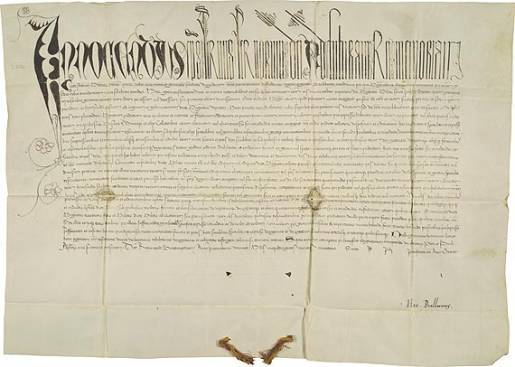
The papal bull of Pope Innocent VIII known as Summis desiderantes (5 December 1484).
During what is known as the Little Ice Age, the grip of freezing weather, failing of crops, rising crime, and mass starvation resulted in an increasing fear of witches. On the request of German inquisitor Heinrich Kramer, Innocent VIII issued the papal bull known as Summis desiderantes(5 December 1484), which supported Kramer’s investigations against magicians and witches:
“It has recently come to our ears, not without great pain to us, that in some parts of upper Germany, [...] Mainz, Koin, Trier, Salzburg, and Bremen, many persons of both sexes, heedless of their own salvation and forsaking the catholic faith, give themselves over to devils male and female, and by their incantations, charms, and conjurings, and by other abominable superstitions and sortileges, offences, crimes, and misdeeds, ruin and cause to perish the offspring of women, the foal of animals, the products of the earth, the grapes of vines, and the fruits of trees, as well as men and women, cattle and flocks and herds and animals of every kind, vineyards also and orchards, meadows, pastures, harvests, grains and other fruits of the earth; that they afflict and torture with dire pains and anguish, both internal and external, these men, women, cattle, flocks, herds, and animals, and hinder men from begetting [...]“
Kramer would later write the polemic Malleus Maleficarum in 1486, which stated that witchcraft was to blame for bad weather. These remarks are included in Part 2, Chapter XV, which is entitled: “How they Raise and Stir up Hailstorms and Tempests, and Cause Lightning to Blast both Men and Beasts”:
“Therefore it is reasonable to conclude that, just as easily as they raise hailstorms, so can they cause lightning and storms at sea; and so no doubt at all remains on these points.”
Both the papal letter appended to the work and the supposed endorsement of Cologne University for it are problematic. The letter of Innocent VIII is not an approval of the book to which it was appended, but rather a charge to inquisitors to investigate diabolical sorcery and a warning to those who might impede them in their duty, that is, a papal letter in the by then conventional tradition established by John XXII and other popes through Eugenius IV and Nicholas V (1447-55).
In 1487, Innocent also confirmed Tomas de Torquemada as Grand Inquisitor of Spain, a role in which he has become infamous.
Innocent VIII died on 25 July 1492 leaving behind him two illegitimate children born before he entered the clergy “towards whom his nepotism had been as lavish as it was shameless” In 1487 he married his elder son Franceschetto Cybo (d. 1519) to Maddalena de’ Medici (1473–1528), the daughter of Lorenzo de’ Medici, who in return obtained the cardinal’s hat for his thirteen-year-old son Giovanni, later Pope Leo X.
July 22, 2013
Ruby, the birthstone of July

Rubies are the birthstone of July and are said to guarantee health, wisdom, wealth and success in love.
Rubies are associated with the sun and were thought to preserve mental and physical health. In the middle ages, rubies were viewed as a stone of prophecy. It was thought the stone darkened when danger was near. Ivan the Terrible of Russia stated that rubies were good for the heart, brain and memory. A 13th century prescription to cure liver problems called for powdered ruby. In the 15th-16th centuries, rubies were thought to counteract poison. When rubbed on the skin, they were also thought to restore youth and vitality.
If a ruby were cast into water it would cause it to boil, and if carved and pressed into wax, would melt the wax.
Although the most well-known magical rubies in modern society are the ruby slippers Dorothy wore in the Wizard of Oz movie, the slippers were silver inthe book. The silver shoes, however, did not show well against the yellow brick road inthe film and so the silver shoes were replaced with ruby slippers, which coukld be more clearly seen.
Take a look at my previous post about the ruby slippers in the Wizard of Oz, “I’ll get you, my pretty… and your little dog too!”
July 18, 2013
Cherries

A love spell from Japan involves tying a strand of hair to a cherry tree in blossom.
Cherries are associated with Venus, water, love, divination, and death. One method to discover how many years of life remain for you is to stand beneath a cherry tree and shake it and count the number of cherries which fall around you, indicating the number of years that remain until your death. Perhaps because of this practice, cherry juice can be used as a substitute for blood in magical recipes.
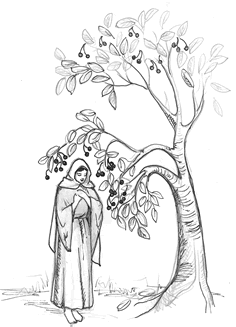
In the former Czechoslovakia it was customary to cut cherry branches on the Feast of St Barbara on 4 December and bring these into the warmth of the house to have blossom at Christmas. However, the tree of course flowers naturally at or around Easter, especially if Easter is late, and in England, in the Chilterns, some of the abundant blossoms were used to decorate churches at Easter.
A cherry orchard will be certain of having a rich crop if the first ripe cherry is eaten by a woman who has just given birth to her first child. However, another Bohemian tale which brings together the Virgin, cherries, birth and death goes: When a mother loses a child, she eats neither strawberries nor cherries until the day of St. John the Baptist (June 24, the traditional date of Midsummer). It is said that at that time the Virgin goes about heaven giving this fruit to the little children. If a mother has not been self-denying, and has eaten of this fruit, when the Virgin comes to the child of such a one, she says: “Poor child, there isn’t much left for you, your mother ate your share.” So mothers of deceased children abstain from fruit until the Midsummer following the child’s death.
Wild cherry folklore has unusual associations with the cuckoo, whereby the bird has to eat three good meals of cherries before it may stop singing. Another use of cherries in predicting death is a children’s oracular rhyme from Buckinghamshire:
‘Cuckoo, cherry tree,
Good bird tell me,
How many years before I die’,
with the answer being the next number of cuckoo calls the singer heard.
July 16, 2013
John Dee, magician extraordinaire
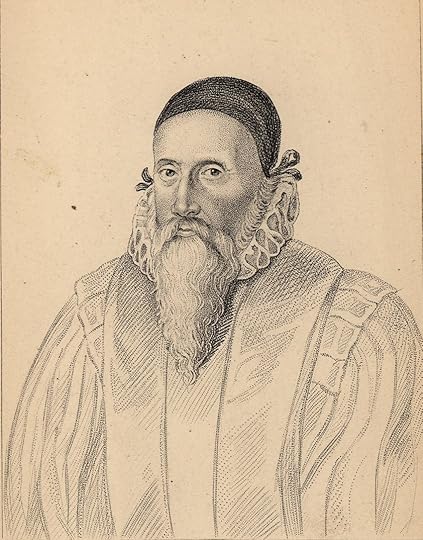
A portrait of John Dee.
John Dee (13 July 1527–1608 or 1609) was a Welsh mathematician, astronomer, astrologer, occultist, navigator, imperialist and consultant to Queen Elizabeth I. He devoted much of his life to the study of alchemy, divination and Hermetic philosophy.
Dee straddled the worlds of science and magic just as they were becoming distinguishable. One of the most learned men of his age, he had been invited to lecture on advanced algebra at the University of Paris while still in his early twenties. Dee was an ardent promoter of mathematics and a respected astronomer, as well as a leading expert in navigation, having trained many of those who would conduct England’s voyages of discovery.
Dee sought to contact angels through the use of a “scryer” or crystal-gazer, who would act as an intermediary between Dee and the angels. Dee’s first attempts were not satisfactory, but, in 1582, he met Edward Kelley who impressed him greatly with his abilities. Dee took Kelley into his service and began to devote all his energies to his supernatural pursuits. These “spiritual conferences” or “actions” were conducted with an air of intense Christian piety, always after periods of purification, prayer and fasting. Dee was convinced of the benefits they could bring to mankind. (The character of Kelley is harder to assess: some have concluded that he acted with complete cynicism, but delusion or self-deception are not out of the question. Kelley’s “output” is remarkable for its sheer mass, its intricacy and its vividness). Dee maintained that the angels laboriously dictated several books to him this way, some in a special angelic or Enochian language.
Dee and Kelley began a nomadic life in Central Europe, but they continued their spiritual conferences, which Dee recorded meticulously. He had audiences with Emperor Rudolf II in Prague Castle. During a spiritual conference in Bohemia, in 1587, Kelley told Dee that the angel Uriel had ordered that the two men should share their wives. Kelley, who by that time was becoming a prominent alchemist and was much more sought-after than Dee, may have wished to use this as a way to end the spiritual conferences. The order caused Dee great anguish, but he did not doubt its genuineness and apparently allowed it to go forward, but broke off the conferences immediately afterwards and did not see Kelley again. Dee returned to England in 1589.





